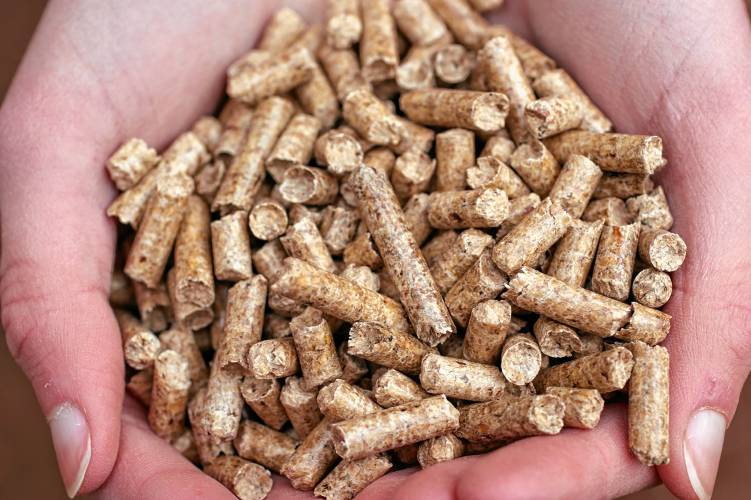Opinion: Climate Action Plan fails without forests

File File
| Published: 02-15-2024 6:00 AM |
Joe Short is vice president of the Northern Forest Center.
As the New Hampshire Department of Environmental Services (NHDES) creates the newest iteration of the state’s Priority Climate Action Plan (PCAP), it must acknowledge and include the key role that New Hampshire forests and forest products play in reducing carbon emissions.
Forest-based strategies are notably absent from the draft Priority Measures.
The 2009 PCAP rightly recognized forestry and wood heat as strategies to combat climate change in ways that also deliver important benefits for the New Hampshire economy and rural communities. It will be a huge oversight if the updated version fails to do the same. A critical tool that is already substantially mitigating the state’s emissions is literally all around us.
New Hampshire is the second-most forested state in the country. Our forest lands absorb and store large amounts of carbon. A healthy wood products economy provides economic incentive to landowners to keep forests thriving and undeveloped while providing a range of benefits such as a renewable supply of wood (for heating, lumber, and forest products), water quality protection, and wildlife habitat.
In addition to mitigating climate change, our forests play a critical role in maintaining the quality of life in our state. The state’s forest products industry generates nearly $1.4 billion in economic output and supports over 7,700 workers each year. Our tourism and outdoor recreation economies are also heavily dependent on healthy forests.
The Climate Action Plan is a key opportunity to reinforce and expand the role that forests play in fighting climate change, and to make near-term reductions in emissions through forest-based strategies.
One of those strategies is modern wood heat. More than 80% of New Hampshire homes are heated with either oil, propane, or natural gas despite the extensive, natural, renewable alternative heat source growing in the forests that surround us. EPA-certified wood and pellet stoves are familiar; there are also advanced, automated systems that conveniently heat whole homes and larger buildings and can integrate with existing heating and hot water systems.
Article continues after...
Yesterday's Most Read Articles
 New Hampshire legalizes public alcohol consumption in designated ‘social districts’
New Hampshire legalizes public alcohol consumption in designated ‘social districts’
 State rules Epsom must pay open-enrollment tuition to other school districts, despite its refraining from the program
State rules Epsom must pay open-enrollment tuition to other school districts, despite its refraining from the program
 Town turmoil: Chichester town administrator resigns again
Town turmoil: Chichester town administrator resigns again
 New Hampshire providers brace for Medicaid changes that reach beyond healthcare
New Hampshire providers brace for Medicaid changes that reach beyond healthcare
 Warner town administrator granted restraining order against selectman
Warner town administrator granted restraining order against selectman
 NH judge decides to pause Trump’s birthright citizenship order
NH judge decides to pause Trump’s birthright citizenship order
Modern wood heat uses wood pellets and chips made from byproducts of forestry, milling, and manufacturing. Replacing fossil fuels with modern wood heat cuts carbon emissions by 50% starting on day one.
This local fuel has a positive effect on carbon reductions and consumer wallets. Cost-effective and price-stable, wood heat is often the cheapest heating fuel available for people without access to natural gas (crucial for rural communities).
While heat pumps contribute to climate stability when paired with renewable energy, they don’t always address the challenge of heating a whole home.
Since many New Hampshire homes have traditional layouts, PCAP’s Priority Measures also need to include modern wood heat systems as a whole home and secondary heat source to provide a renewable option where heat pumps won’t work well.
While effective for cooling and heating during shoulder season, heat pumps become less efficient during cold days which leads to two is sues.
First, more energy used during peak days means a more expensive electricity bill for residents. New Hampshire has some of the highest electricity rates in the country. While the up-front costs of installing a whole-home modern wood heating system are relatively high, the ongoing fuel costs are low and fluctuate less month-to-month than all other heating sources, including electricity. For example, from January 2021 through December 2022, the cost of wood pellets increased only 20% compared to 50% for natural gas and 83% for oil.
Second, heat pumps are not always fueled with renewable energy. In 2022, only 14% of New Hampshire’s electricity generation came from renewable resources. Coal-fired plants no longer supply baseload power, but they play an important role in providing electricity on high-demand days.
Heat pumps need a complement to ensure electricity bills and greenhouse gas emissions don’t spike during extremely cold days. As New Hampshire builds the infrastructure for renewable electrification, modern wood heat is the bridge to the future, providing a way to conserve our working forests and reduce emissions.
Another forest strategy for carbon reduction is substituting mass timber for steel and concrete in our built environment, which generates three significant climate benefits.
First, using wood avoids the emissions associated with the carbon-intensive processes of creating steel, concrete, and petroleum products. Second, the structural wood components store all of the wood’s carbon for the life of the building. Instead of releasing carbon into the atmosphere, mass timber buildings act as storage vaults for carbon. And finally, new trees will grow in the forest where the wood was harvested and absorb more carbon as they grow.
In addition to its sustainability and light carbon footprint, mass timber provides enhanced aesthetics, comes in a variety of forms, and with speedier construction and light weight can reduce costs. It also performs better in a fire than other materials due to its inherent charring ability, which protects the underlying wood, while steel and concrete can lose their strength and structural integrity when exposed to high temperatures.
Mass timber products, such as Cross Laminated Timber, help us build more quickly and efficiently, constructing homes, offices, and buildings in record time while reducing emissions.
In short, forests play three crucial roles in reducing carbon: they sequester carbon while they grow, reduce emissions by storing carbon in live trees and long-lasting wood products, and displacing fossil fuels.
Please urge NHDES to ensure the revised PCAP takes advantage of all the ways forests and wood can reduce carbon emissions. Share your written comments by Feb. 20 (Email cprg@des.nh.gov).







 Opinion: Trumpism in a dying democracy
Opinion: Trumpism in a dying democracy Opinion: What Coolidge’s century-old decision can teach us today
Opinion: What Coolidge’s century-old decision can teach us today Opinion: The art of diplomacy
Opinion: The art of diplomacy Opinion: After Roe: Three years of resistance, care and community
Opinion: After Roe: Three years of resistance, care and community
